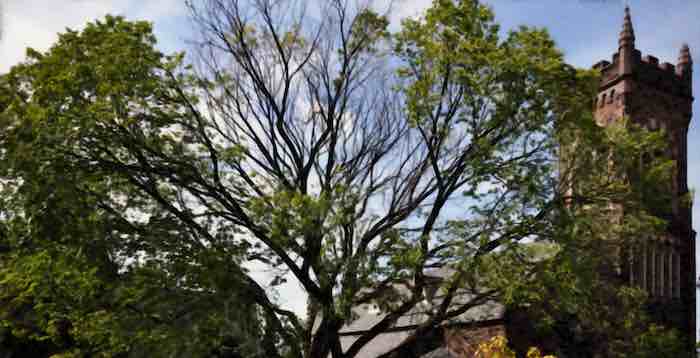
It is considerably unfair that this devastating disease is so named. First officially identified in France in 1918, soon after that in Holland, Belgium and Germany, it had reached England by 1927. But it was Dutch botanists who discovered the cause: a pathogenic fungus,
Ceratocystis ulmi, spread by two beetles,
Scolytus multistriatus and
S. scolytus.
It emigrated from Europe to the United States in 1930 through a shipment of logs unloaded in New York and destined for Ohio. By the 1940s it was infecting
Ulmus americana from Quebec to Kentucky; a decade later it was identified as far west as Kansas. The battle lines are now drawn in Saskatchewan cities where detection and immediate removal of infected specimens is currently holding it at bay.
The American Elm,
Ulmus americana, is native from Nova Scotia to Texas and was widely planted as a street tree. In Europe, its cousin
U. procera was equally widely spread if not always appreciated.
Long before an elm sheltered the Duke of Wellington at Waterloo,
U. procera was notorious for the tree's narrow crotches. This could and would cause branches to suddenly separate, bad or good weather, on unfortunates sheltering beneath. Rebecca Rump records the English as warning "The Ellum hateth man and waiteth," or, in the view of equally suspicious French, "I'll meet you under the elm," i.e. until hell freezes over.
Nevertheless, its water-resistant qualities were appreciated, it being much favoured for coffins. However, this was not presumably the reason why
U. americana was proclaimed at the state tree of both North Dakota and Massachusetts
None of this has protected either tree against ravaging by
Scolytus multistriatus and
S. scolytus. The wee beasties can fly up to 18 miles in search of new victims. Upon arriving upon an unhappy host, nuptial chambers are chewed in in the bark. Following the coupling, the female bores a channel between the bark and sapwood to lay about 70 eggs; when the larvae hatch they tunnel off at right angles to the channel; after feeding voraciously, they pupate and later emerge as adult beetles through the easily identifiable precisely round holes.
A healthy elm might shrug off these attacks but not the actual cause of the disease, the pathogenic fungus
Ceratocystis multistriatus, spread by the beetles. To defend itself, the elm attempts to block the channels with gum but in effect commits
hari kari by blocking off too many of its nutrient conducting plumbing.
The problem is presumed to have originated in the Far East. Native Chinese Elm, known also as Lacebark Elm,
Ulmus parvifolia and the so-called 'Chinese' Elm, correctly Siberian Elm,
Ulmus pumila are both are resistant to 'Dutch' elm disease. Consequently, attempts continue to create disease-resistant hybrids although these, so far, have not reached the stature of either American or European species.
At present, sanitation--rapid removal of infected trees--remains the only practical control. In the United States, a genetically modified bacterium has been demonstrated to kill the fungus, but its distribution has been blocked by environmental concerns.
 It is considerably unfair that this devastating disease is so named. First officially identified in France in 1918, soon after that in Holland, Belgium and Germany, it had reached England by 1927. But it was Dutch botanists who discovered the cause: a pathogenic fungus, Ceratocystis ulmi, spread by two beetles, Scolytus multistriatus and S. scolytus.
It emigrated from Europe to the United States in 1930 through a shipment of logs unloaded in New York and destined for Ohio. By the 1940s it was infecting Ulmus americana from Quebec to Kentucky; a decade later it was identified as far west as Kansas. The battle lines are now drawn in Saskatchewan cities where detection and immediate removal of infected specimens is currently holding it at bay.
It is considerably unfair that this devastating disease is so named. First officially identified in France in 1918, soon after that in Holland, Belgium and Germany, it had reached England by 1927. But it was Dutch botanists who discovered the cause: a pathogenic fungus, Ceratocystis ulmi, spread by two beetles, Scolytus multistriatus and S. scolytus.
It emigrated from Europe to the United States in 1930 through a shipment of logs unloaded in New York and destined for Ohio. By the 1940s it was infecting Ulmus americana from Quebec to Kentucky; a decade later it was identified as far west as Kansas. The battle lines are now drawn in Saskatchewan cities where detection and immediate removal of infected specimens is currently holding it at bay.